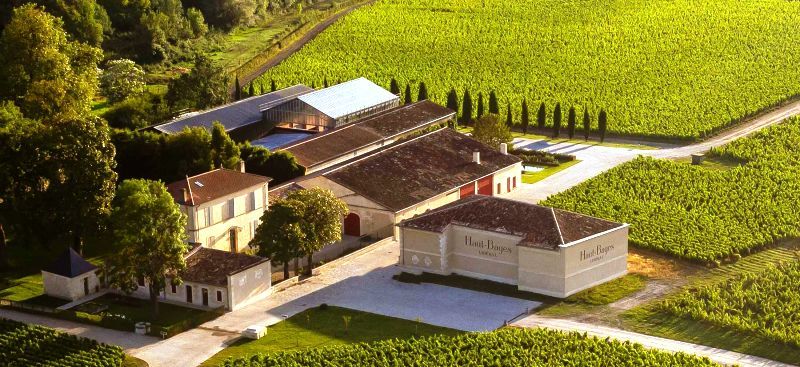organic wine, biodynamic wine, Demeter wine, na... Organic wine estates Château Haut Bages Liberal, Pauillac, Bordeaux
Château Haut Bages Liberal, Pauillac, Bordeaux

The name Haut Bages Libéral refers, on the one hand, to the topographical designation of the highest point in the Pauillac, called Bages, from which one can overlook the Gironde. Both the château and the winery's best vineyards are located here.
Libèral, the name of one of the château's many owners, was only added at the beginning of the 18th century. Over time, the best terroirs in the south of the Pauillac appellation were acquired and in 1855 the Château Haut Bages Libéral was awarded the title of Grand Cru Classé.
Claire Merlaut Lurton
The Merlaut family bought the property in 1982. Jacques Merlaut gave his eldest daughter Bernadette the technical and commercial management. After her tragic death, Claire, Bernadette's daughter, was trained under the leadership of her grandfather by the best teachers and connoisseurs of Bordeaux with the aim of taking over the management of the Château Haut Bages Libéral.
From 2000 onwards, Claire dedicated herself with passion and conviction to the task of doing justice to the estate's magnificent terroir. From 2007 she became interested in the idea of biodynamic viticulture in order to combine it with agroforestry techniques. Their goal was to express the naturally existing potential of the terroir in the wines.
AN EXCEPTIONAL TERROIR ON THE BANKS OF THE GIRONDE
Half of the vineyards at Château Haut-Bages Libéral lie on the historic Bages plateau (gravel soil), while the other half faces directly onto the Gironde (limestone hills). The estuary is a carrier of energy, microclimate and biodiversity and contributes significantly to the exceptional quality of the terroir, as the Médoc saying goes:
“GREAT TERROIRS LOOK TOWARDS THE RIVER”
The proximity to water also gives the vineyard a clayey-calcareous soil type that makes it unique. The wines of Château Haut-Bages Libéral develop a mineral character that sets them apart.
Agroecology and agroforestry
Since the 2000s, biodiversity has been at the heart of all winemaking practices at Château Haut-Bages Libéral The plots are surrounded by hedges and trees of different species (peach trees, apple trees, maples, poplars, dogwoods, elms, etc.) are gradually planted in the middle of the vines. The floors are covered with permanent vegetation or seedlings (rye, mustard, clover, broad beans, lupins, etc.). These plants cover the soil, protect it from drying out, and they root through the soil, which can therefore absorb water better. They form nitrogen which is gradually available to the vines, fertilizes them and over time it forms humus. Microorganisms, insects, birds and animals prevent or reduce epidemic infestations of harmful insects and diseases.

Château Haut Bages Libéral
Agroecology and agroforestry combine all agricultural practices for environmentally friendly cultivation and promote the sustainability and biodiversity of the ecosystem. Today we know that mixed forests, with their biodiversity, survive heat and drought better than spruce forests planted in monoculture. A wine-growing area whose natural vegetation is removed with herbicides is comparable to a sterile spruce forest. In this respect, one can assume that the species and plant diversity in the vineyard with hedges and trees can protect the vineyard from drought and be a natural opponent for diseases and pests through their evapotranspiration.
Trees and catch crops capture carbon from the atmosphere through photosynthesis. This carbon is returned to the soil in the form of organic material as the plants and their roots are broken down by microorganisms. These materials are organic matter as well as minerals, amino acids, phosphorus, sulfur, potassium, magnesium, calcium, which are returned to the soil, making them available to plants. This assimilation process is facilitated by mychorizal fungi. In symbiosis with plants, they absorb water, nutrients and minerals and then distribute them to the plants, which are converted into sugars and carbohydrates in the plants. The mycelia of mycorrhizas form very extensive, interconnected underground networks that allow plants to utilize up to ten times the volume of soil. Herbicides, fungicides and insecticides destroy this natural protective mechanism.
New Château Haut Bages Liberal Pauillac,5eme Grand Cru Classé, biodyn. € 39.60Product no.: 045440.00 € / bottle(s) *
1 l = 53.33 €
Delivery period 1-3 days |
![Biowein [pur] Hartl - organic wine shipper](/WebRoot/Store7/Shops/87b180e2-5584-4f7d-8168-acd5dfe63e0b/Styles/Sharp[3]/logo.png)




